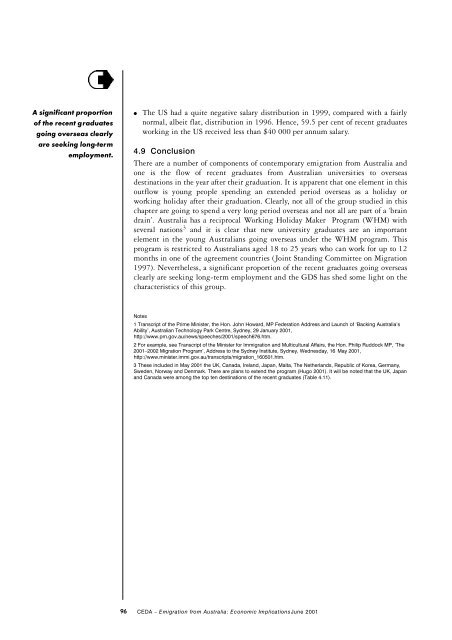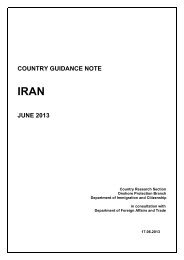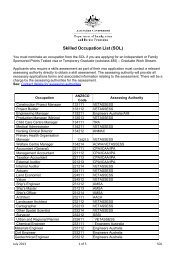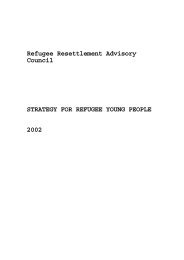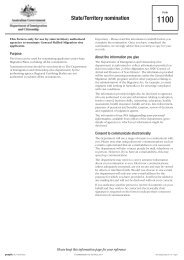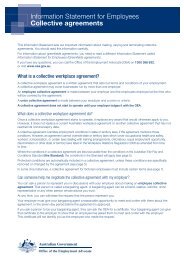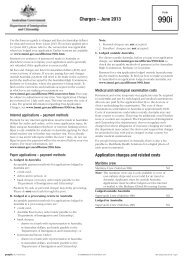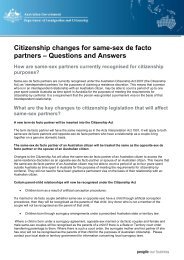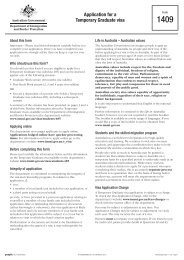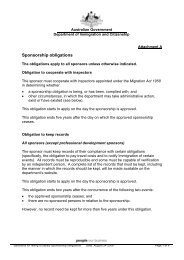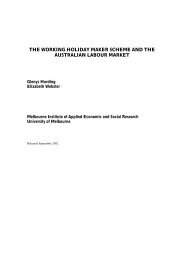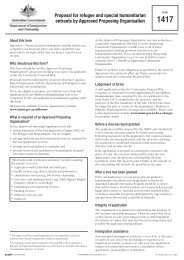part three - Department of Immigration & Citizenship
part three - Department of Immigration & Citizenship
part three - Department of Immigration & Citizenship
You also want an ePaper? Increase the reach of your titles
YUMPU automatically turns print PDFs into web optimized ePapers that Google loves.
A significant proportion<br />
<strong>of</strong> the recent graduates<br />
going overseas clearly<br />
are seeking long-term<br />
employment.<br />
●<br />
The US had a quite negative salary distribution in 1999, compared with a fairly<br />
normal, albeit flat, distribution in 1996. Hence, 59.5 per cent <strong>of</strong> recent graduates<br />
working in the US received less than $40 000 per annum salary.<br />
4 . 9 C o n c l u s i o n<br />
T h e re are a number <strong>of</strong> components <strong>of</strong> contemporary emigration from Australia and<br />
one is the flow <strong>of</strong> recent graduates from Australian universities to overseas<br />
destinations in the year after their graduation. It is apparent that one element in this<br />
outflow is young people spending an extended period overseas as a holiday or<br />
working holiday after their graduation. Clearly, not all <strong>of</strong> the group studied in this<br />
chapter are going to spend a very long period overseas and not all are <strong>part</strong> <strong>of</strong> a ‘brain<br />
drain’. Australia has a re c i p rocal Working Holiday Maker Program (WHM) with<br />
several nations 3 and it is clear that new university graduates are an import a n t<br />
element in the young Australians going overseas under the WHM program. This<br />
p rogram is restricted to Australians aged 18 to 25 years who can work for up to 12<br />
months in one <strong>of</strong> the agreement countries (Joint Standing Committee on Migration<br />
1997). Nevertheless, a significant pro p o rtion <strong>of</strong> the recent graduates going overseas<br />
clearly are seeking long-term employment and the GDS has shed some light on the<br />
characteristics <strong>of</strong> this gro u p .<br />
Notes<br />
1 Transcript <strong>of</strong> the Prime Minister, the Hon. John Howard, MP Federation Address and Launch <strong>of</strong> ‘Backing Australia’s<br />
Ability’, Australian Technology Park Centre, Sydney, 29 January 2001,<br />
http://www.pm.gov.au/news/speeches/2001/speech676.htm.<br />
2 For example, see Transcript <strong>of</strong> the Minister for <strong>Immigration</strong> and Multicultural Affairs, the Hon. Philip Ruddock MP, ‘The<br />
2001–2002 Migration Program’, Address to the Sydney Institute, Sydney, Wednesday, 16 May 2001,<br />
http://www.minister.immi.gov.au/transcripts/migration_160501.htm.<br />
3 These included in May 2001 the UK, Canada, Ireland, Japan, Malta, The Netherlands, Republic <strong>of</strong> Korea, Germany,<br />
Sweden, Norway and Denmark. There are plans to extend the program (Hugo 2001). It will be noted that the UK, Japan<br />
and Canada were among the top ten destinations <strong>of</strong> the recent graduates (Table 4.11).<br />
96 C E DA – Emigration from Australia: Economic ImplicationsJune 2001


